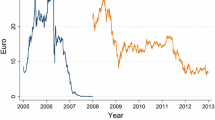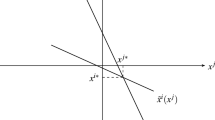Abstract
This paper provides a detailed analysis of ex-post efficient permit markets. After a short review of institutional designs that can achieve ex-post efficiency under uncertainty and asymmetric information, we analyze the effects of an ex-post efficient regulation on the expected costs of the regulated firms, on their investment behavior, and on the incentives for strategic behavior on imperfectly competitive permit markets. Also we inquire about the budget effects of the regulation. Our results show that ex-post efficient permit markets have considerable benefits beside the direct increase in expected social welfare.
Similar content being viewed by others
References
Chao H-P and Wilson R (1993). Option value of emission allowances. J Regul Econ 5: 233–249
Collinge RA and Oates WE (1982). Efficiency in pollution control in the short and long runs: a system of rental emission permits. Can J Econ 15: 178–188
Fischer C, Parry IWH and Pizer WA (2003). Instrument choice for environmental protection when technological innovation is endogenous. J Environ Econ Manage 45: 523–545
Hahn RW (1984). Market power and transferable property rights. Quart J Econ 99: 753–765
Henry C (1989). Microeconomics for public policy. Clarendon Press, Oxford
Insley MC (2003). On the option to invest in pollution control under a regime of tradable emissions allowances. Can J Econ 36: 860–883
Kennedy PW (1999). Learning about environmental damage: implications for emissions trading. Can J Econ 32: 1313–1327
Milliman SR and Prince R (1989). Firm incentives to promote technological change in pollution control. J Environ Econ Manage 17: 247–265
Moledina AA, Coggins JS, Polasky S and Costello C (2003). Dynamic environmental policy with strategic firms: prices versus quantities. J Environ Econ Manage 45: 356–376
Newell RG, Pizer WA and Zhang J (2005). Managing permit markets to stabilize prices. Environ Resour Econ 31: 133–157
Pizer WA (2002). Combining price and quantity controls to mitigate global climate change. J Public Econ 85: 409–434
Requate T and Unold W (2003). On the incentives of environmental policy to adopt advanced abatement technology – will the true ranking please stand up?. Eur Econ Rev 47: 125–146
Roberts MJ and Spence M (1976). Effluent charges and licenses under uncertainty. J Public Econ 5: 193–208
Unold W and Requate T (2001). Pollution control by options trading. Econ Lett 73: 353–358
Weitzman ML (1974). Prices vs quantities. Rev Econ Stud 41: 477–491
Westskog H (1996). Market power in a system of tradeable CO2 quotas. Energy J 17: 85–103
Zhao J (2003). Irreversible abatement investment under cost uncertainties: tradable emission permits and emission charges. J Public Econ 87: 2765–2789
Author information
Authors and Affiliations
Corresponding author
Rights and permissions
About this article
Cite this article
Krysiak, F.C. Ex-post efficient permit markets: a detailed analysis. Environ Resource Econ 39, 397–410 (2008). https://doi.org/10.1007/s10640-007-9132-5
Received:
Accepted:
Published:
Issue Date:
DOI: https://doi.org/10.1007/s10640-007-9132-5




